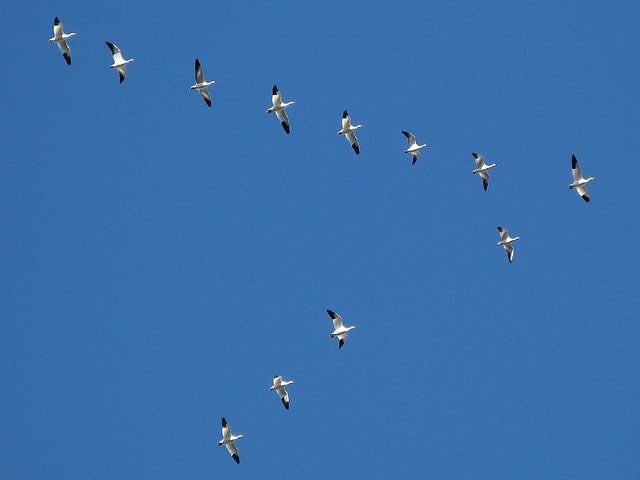 Creativecommons.org/Gilles Gonthier
Creativecommons.org/Gilles Gonthier
Every spring, Quebecers gaze skyward, watching for the geese to arrive. These migratory birds are easily recognizable thanks to their V-shaped flight formation and the din of their cries heralding the return of warmer weather.
Literally hundreds of thousands of snow geese flock to the St Lawrence River, where they enjoy a well-deserved break before resuming their journey to the Far North — an annual voyage of nearly 4,000 km.
An unbelievable feast for the eyes and ears, the immense flocks transform the river into a rippling sea of white as the air fills with deafening cries. And when these valiant vagabonds suddenly take wing, the sight of their breathtaking aerial ballet is the stuff of legend.
The snow goose can be observed in different regions of Québec from the end of March to the end of May. Its three favourite staging areas are Lac Saint-Pierre, Cap Tourmente and the Montmagny region.
 Creativecommons.org/Rosana Prada
Creativecommons.org/Rosana Prada
It’s Snowing Geese In Lac Saint-Pierre
Lac Saint-Pierre and its 103 islands — forming the St Lawrence’s largest archipelago — are the first springtime staging area for snow geese. Designated a biosphere reserve by UNESCO in November 2000, this territory is still 90 per cent wilderness and accounts for 40 per cent of the St Lawrence wetlands.
Greater snow geese take sustenance from its rich marshes before continuing their long and perilous trip north. It’s also possible to observe these magnificent migratory birds on the south shore of Lac Saint-Pierre along highway 132, between Sorel and Nicolet, at the Centre d’interprétation de Baie-du-Febvre. The site is equipped with an observation tower and tunnel several metres in length.
 Creativecommons.org/Rosana Prada
Creativecommons.org/Rosana Prada
Awash With White In Cap Tourmente
Cap Tourmente National Wildlife Area is another preferred spot of the snow goose, not to mention a choice site for observing them. In fact, the goose stops there in the fall, as well as in spring.
Each year, flocks of snow geese descend on the site’s fertile sandbars. Protected for the past 40 years, this natural environment is home to no fewer than 300 bird species, 45 mammal species and 700 plant species, and boasts an 18-kilometre network of hiking trails.
There Are Millions in Montmagny
Lastly, the Montmagny region, on the south shore east of Québec City, comes alive in the month of March and is the centre of a springtime celebration.
With a population nearing one million geese, the colony takes a break on the shores of Montmagny and on the islands that form its archipelago. It’s a pristine setting from which travellers can gaze upon the spectacular natural performance put on by the snow goose. In the spring, when colours are at their prettiest, nature walks are organized for ornithologists, birdwatchers and tourists.
Goose-Gazing Tips
To get the most out of your visit to an observation ground, find out about the birds’ movements and inform yourself on the various species present. In some places, the sunrise and sunset are good times to witness mass take-offs. At high tide, snow geese generally approach the shore, where they are easily spotted plunging their heads into the mud to feed. Be attentive and patient: nature and climate have the upper hand, especially when it comes to geese!


